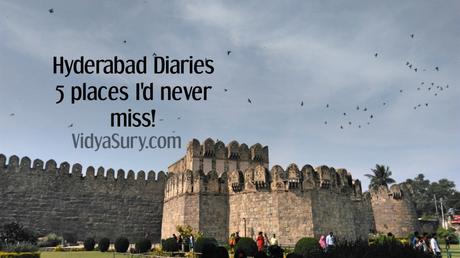
I've spent more than a third of my life in Hyderabad and consider it my spiritual hometown. Some of my happiest years were spent there-I am talking real cozy with my Grandmother, Mom and Uncle. Part of my schooling and college years were here, and later, a good part of my working career. I just love the twin cities!
Naturally, I grab any excuse to visit-and I am always wishing that any out-of-town trip would automatically be Hyderabad. Sigh. If wishes were horses, I'd be galloping there all the time. Many of my schoolmates, with whom I am in touch, still live there. Also, quite a few family friends.
I am in the mood to make a list of five of my favorite places in Hyderabad today.
Situated in the southern state of Telangana, Hyderabad is where old meets new. Filled with fabulous timeless architecture, culture and history along with new tech buildings and rapidly expanding landscapes of modern India, Hyderabad is a growing destination for tourists in India. There are frequent flights to Hyderabad from all major cities.
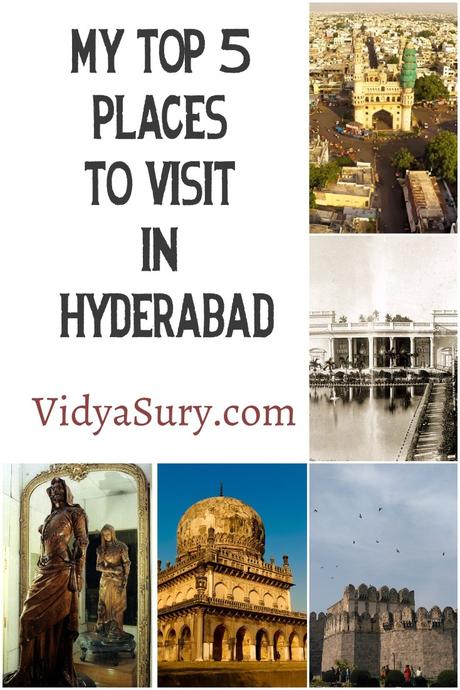
Here are the top 5 places to visit in Hyderabad.
The Arc de Triomphe of the East: Charminar
This iconic monument instantly represents Hyderabad. The Charminar or "four minarets" is almost 450 years ago and celebrates the end of the plague. Built by Quli Qutb Shah on the banks of the Musi river at the intersection of the historical trade route connecting the markets of Golkonda with the port city of Machilipatnam, it is in the center of the old city. The second floor of the has the oldest mosque of the city on the western side of the roof. The eastern part used to be the court at the time of Sultan Qutb Shah. There are two galleries inside the Charminar - one over the other. The minarets are supported by four grand arches. You can see the influence of Islamic, Persian and Hindu architecture. In 1889, four clocks were added along the four cardinal directions. I have wonderful memories of spending all day in this area, visiting the shops and simply soaking in the ambience that's the essence of this place.
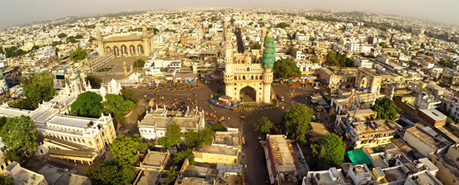
There's a story that an underground tunnel connects the Charminar with the Golkonda fort, apparently as a safe route for kings and queens to escape in an emergency-although so far none has been found. Doesn't mean it doesn't exist....
The Charminar is a hub for festival celebrations, especially Ramzan and a great tourist attraction with its surrounding markets where you can literally shop till you drop and negotiate your heart out. Towards the west is the Laad Bazaar and to the southwest is the gorgeous Macca Masjid. We always visit the masjid-legend has it that if you sit on a particular bench in the courtyard you will definitely visit Hyd again. Not that I need incentive like that, but still!
Hyderabad's Glory: The Golconda Fort
Also known as "Shepherds Hill," the Golconda Fort (gol = round; conda = hill) is an architectural marvel. One of the greatest gems in Hyderabad, the fort was built by the Qutb Shahs as a citadel in the 16th century atop a 120m hill. It is among the biggest fortresses in Asia. A UNESCO World Heritage site, Golconda Fort brings together archaeology, architecture and history and takes you back to the kings and rulers of India.
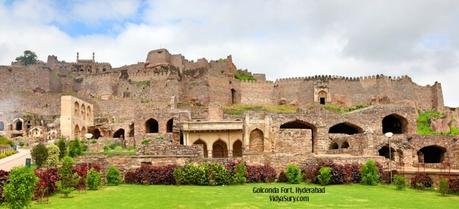
This region is known for the mines from where some of the world's most famous gems, including the Koh-i-Noor, the Hope Diamond, Nassak Diamond, Regent Diamond. and the Noor-ul-Ain came.
The Golconda fort complex is easily a day trip since it is spread across 11 kilometers and pretty tiring to cover. One of its specialties is the acoustic effect - if you clap your hands at the entry into Golconda, which is the lowest point called the Fateh Darwaza - someone at the highest point almost a kilometer away at the Bala Hisar baradari or pavilion! This was basically to warn the Royals if there was an invasion. I remember during my childhood, when we visited the fort, some of us would quickly make it to the top just to hear this! And the view from there is gorgeous! I can imagine how the Kings felt when they looked around.
Best to time your visit so you can enjoy the sound and light show in the evening-it is breathtaking!
Tribute to an entire dynasty: The Qutub Shahi Tombs
Not far from the Golconda fort are the Qutub Shahi tombs, built by the Qutub Shahis and later renovated by Sir Salar Jung III in the 19 th century. The Qutub Shahs ruled the city in the 18 th century and their strong influence is obvious. Inspired by Hindu and Persian architecture, gardens, domed structures, parapets and ornamentation cover the many tombs that line the northwest end of Golconda Fort. The tombs themselves are made of grey granite and each tomb is surrounded by pointed arches which add to its beauty. They are all of different sizes. Smaller tombs are one storey while larger ones are double storeyed. Seven of the eight rulers are buried here as well as their descendants.
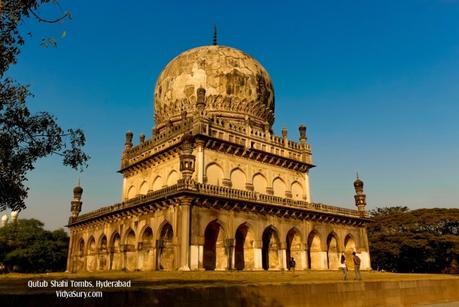
In their time, the tombs were gorgeously decorated by this has faded over the years. Mohammed Quli Qutub Shah's tomb is the largest and stands 42 meters tall with 28 open arches, a large dome and minarets at the four corners.
You can also see the tomb of Sultan Quli Qutub-ul-Mulk, the founder of the Qutub Shahi Dynasty, who not only built his own tomb but oversaw this mammoth architectural project. The tombs also house non-ruling royal family members and their nephews, nieces and siblings.
It is divine to spend a day there, admiring the beauty of this ancient architecture, enjoying the ambience and history of this remarkable attraction. I have wonderful memories of picnics here with family. It is utterly peaceful to simply sit there and savor the silence.
The Chowmahalla Palace
Not far from the Charminar, is the Chowmahalla palace or four palaces brought together at the center of the city. This was built during the reign of Nizams for entertaining royal visitors and guests over 200 years ago and known for its unique style. Originally 45 acres, it now spans 12 acres of the city where guests can marvel over its pristine architecture and landscape.

(Image By Lala Deen Dayal (1844-1905) - British Library, Public Domain, Link)
There are two courtyards - the southern and northern courtyards and the grand Khilwat or Durbar hall, along with gorgeous fountains and gardens. Between 2005 and 2010, the palace was restored and opened to the public. The southern courtyard is the oldest part of the palace with four palaces - Afzal Mahal, Mahtab Mahal, Tahniyat Mahal and Aftab Mahal. In the northern courtyard is the Bara Imam, a long corridor of rooms on the east with a view of the central fountain and pool that used to have the administrative wing. There are Mughal style domes and arches with Persian elements. Opposite this is a building that's a mirror image of the Bara Imam and used as guest rooms.
The Khilwat Mubarak is the heart of the Chowmahalla Palace, the seat of the Asaf Jahi dynasty. The grand Durbar Hall is an amazing sight, with a marble platform that housed the royal seat. There are spectacular Belgian crystal chandeliers here.
Above the main gate to the palace is the Khilwat clock that has been working for more than 250 years and is regularly maintained.
There's a council hall with a collection of manuscripts and books that is now used for exhibitions. The Roshan Bangla is where the sixth Nizam used to live. And oh, the palace has a fabulous collection of vintage cars used by the Nizams.
Barely two kilometres from here is the Nizam Museum at the Purani Haveli, were you can see all the gifts, antiques and other priceless souvenirs and treasures of the Nizam. These include a golden throne, vintage cars and the Nizam's wardrobe. There's an ancient manually operated lift as well as massive drums.
Salar Jung Museum
One of the three national museums in India and among the largest in the world, the Salar Jung Museum is reputed to be a one-man collection of ancient manuscripts, ceramics, metallic artifacts, carpets, sculptures, textiles, paintings and clocks. There are displays from different civilizations. Some of the important antiques here are daggers that belonged to Empress Noor Jahan, Emperor Jehangir and Emperor Shah Jahan. The ancient artifacts belong to the Salar Jung family with the collections dating back to the 1st century.
There are paintings of the famous Raja Ravi Varma, Tipu Sultan's wardrobe, daggers studded with gems that belonged to ancient kings and queens, Aurangzeb's sword and jewel encrusted boxes. There's an ancient furniture collection that belongs to the 14th and 17th centuries. Other fabulous exhibits include the statue of 'Veiled Rebecca', Mughal miniatures, European sculptures, Chinese porcelain, embroidery works, metal-ware, jade carvings, Japanese silk paintings and ivory works. There's also a Quran collection.
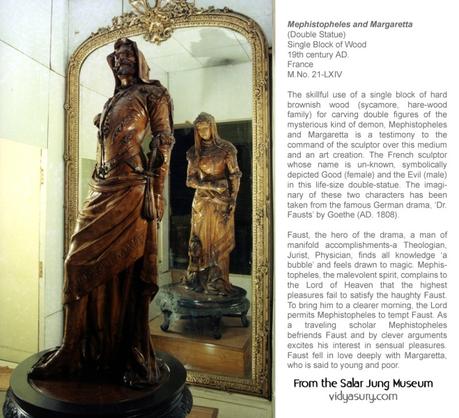
A unique statue is that of Mephistopheles and Margaretta - a double sided statue with Mephistopheles on one side and Margaretta on the other. Plaster of Paris replicas are sold at the souvenir shop at the museum and a friend of ours carried one on their Delhi to Hyderabad flights and managed to bring it home intact.
The 'Lady with the Lamp' is another beautiful sculpture. The 19th Century British Musical Clock is the most prized artifact among the other three hundred clocks within the museum. Visitors flock in front of the clock on the ground floor at noon to see the clock strike twelve.
There are 38 galleries spread across two floors with 28 on the ground floor and eighteen on the first floor, a library, a cafeteria, a shop selling mementoes and a reading room. Cameras are not allowed and must be deposited in the counter at the side of the museum. Sigh. Recently, they've added a children's gallery to the museum.
I've only touched the tip of the iceberg here - there's so much more to see in Hyderabad. There's shopping to do, pearls to shop, delicious food to eat and...and...and....sooo much to do.
And of course, it goes without saying that you cannot leave Hyderabad without enjoying its delicious biryani and osmania biscuits and pauna chai. If you haven't been to Hyderabad, December is a wonderful time to visit.


